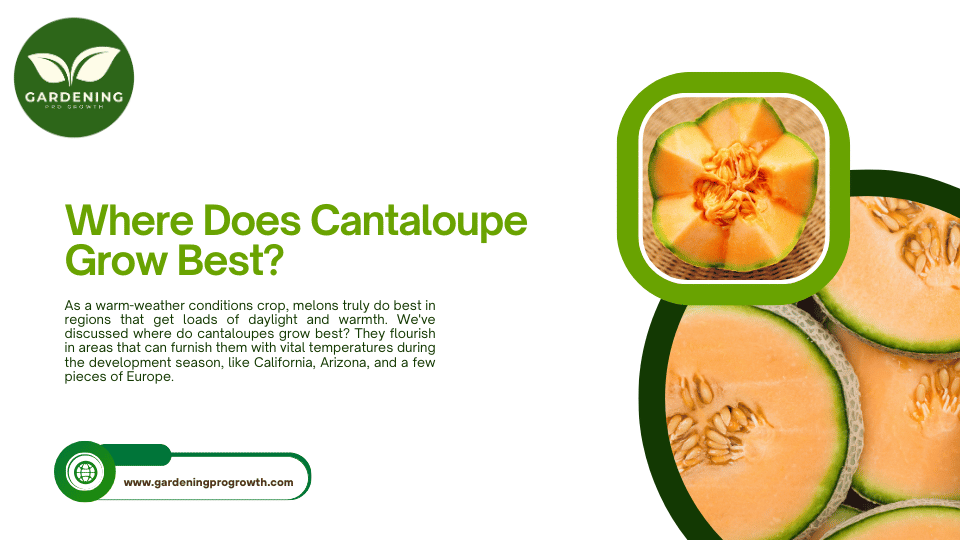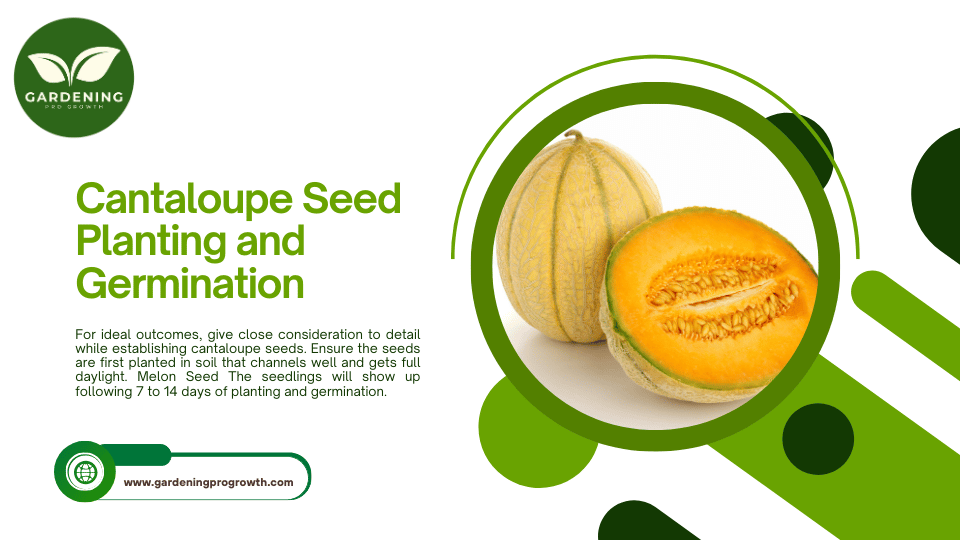Quite possibly the dearest melon on earth, melons are esteemed for their delightful, sweet tissue and profoundly nutritious substance. This article for melon kinds will help both melon sweethearts and landscapers in choosing the best cultivars for their needs. You will be exceptional in picking and developing melons in your garden if you have superior information on the many kinds, development counsel, and the best types for various regions. This article will tell you through the universe of melons whether you are an experienced gardener or are simply beginning with your Kitchen Garden and Gardening Pro Growth.
Cantaloupe Facts and Characteristics
Cucumbers and pumpkins have a place in a similar family as melons, which is Cucurbitaceae. Despite much of the time being confused with different melons, they have special characteristics. An often posed inquiry is, Is a cantaloupe a fruit or vegetable? It’s not difficult to reply melon is a natural product. It is notable for the two its reviving sweetness and high vitamin A and C substance.
How much does a cantaloupe weigh? Melons regularly gauge two to five pounds, while bigger kinds might weigh more. These qualities, along with their tastiness, make them a well-known organic product for home cultivating and snacking.
Where is Cantaloupe Grown?

They are developed everywhere, where are cantaloupes grown most successfully? Developing melons need a warm, bright climate. The US, Mexico, and a few Mediterranean countries including Spain and Turkey are the top makers. The extended developing seasons and moderate temperatures found here are great for melons to develop their flavour.
The main issue for home landscapers is, where do cantaloupes grow best? Melons flourish in regions with warm temperatures and soil that channels fittingly. Cultivating melons can be made more productive by knowing the phases of plant development and how to deal with them. The solution to the inquiry “Where do cantaloupe melons come from?” demonstrates that melons have generally been developed in warm, calm districts of the world, which makes them an essential part of worldwide farming.
Different Types of Cantaloupe Cultivars
It’s critical to consider the different cultivars that are available while investigating Cantaloupe types of melons. Melons are available in various sizes, shapes, and flavors, each with extraordinary characteristics of their own. Understanding the different cantaloupe melons is fundamental, whether you are developing for business creation or simply adding to your home garden.
The most popular types of cantaloupe melon are:
- Athena Cantaloupe: Athena cantaloupe is a notable kind that is ideal for transportation and selling because of its strong tissue and expanded period of usability.
- Hale’s Best Jumbo: Remarkable for having a strong musky fragrance and a pleasant taste.
- Ambrosia Cantaloupe: Home gardener workers love this melon for its extra-delicious surface and sweet flavor. It is exceptionally esteemed.
- Charentais: The French melon known as Charentais is little and fragrant, with a smooth skin and rich flavor.
- Sugar Cube: This little, sweet sort is great for little gardens or single servings.
- Minnesota: This type fills well in little nursery plots, making it ideal for gardeners with restricted regions.
- Crane Melon: An exceptional sort with tissue that is profoundly orange in variety of cantaloupe and a strikingly unobtrusive flavor.
- Galia Melon: This melon-honeydew hybrid has a honey-like sweetness to it.
- Sivan F1: Sivan F1 is a crossover cultivar eminent for its extraordinary yields and flexibility to illness.
- Rocky Ford: A well-known American kind with a sweet flavor and strong surface.
You might pick which different types of cantaloupe melons to deliver or buy by having an exhaustive comprehension of these varieties. Certain varieties of cantaloupe melon work better when eaten new, while others function admirably when delivered or put away.
Cantaloupe Growing Tips
Is cantaloupe hard to grow? Although certain individuals might accept that developing cantaloupe needs refined planting information, it’s quite possible given the right conditions. For the best root advancement, the dirt should be somewhat sandy, very much depleted, and wealthy in natural matter. Watering the melons consistently is urgent to hold them back from drying out or getting excessively severe, particularly when they are aging. Then again, remember that overwatering could bring about parasitic diseases and root decay.
How to choose a good cantaloupe?
Choosing infection-safe cultivars, such as Sivan F1, will decrease the probability of normal nuisances and sicknesses, working with a more consistent developing experience. Plants should be separated fittingly, in a perfect world two feet separated, to consider sufficient air course and lessen the probability of mold, which is an ordinary issue in humid conditions.
Choosing the Right Cantaloupe Variety
Knowing which cantaloupe kind to plant is fundamental for an extraordinary harvest, however knowing which one to pick is as well. Ensure the seeds you pick are fitting for your developing region and that they come from dependable providers. Successful germination can be expanded by using suitable establishing rehearses, such as setting seeds one inch somewhere down in warm soil (around 70°F).
Where Does Cantaloupe Grow Best?

As a warm-weather conditions crop, melons truly do best in regions that get loads of daylight and warmth. We’ve discussed where do cantaloupes grow best? They flourish in areas that can furnish them with vital temperatures during the development season, like California, Arizona, and a few pieces of Europe. To ensure a successful cantaloupe harvest, follow expert-backed growing tips, choose disease-resistant varieties, and learn from real-life gardening experiences for best results.
Where is cantaloupe grown most successfully? A few of the main makers in the globe, including Iran, Spain, and the US, have environments that are great for melon cultivation. Landscapers in hotter environments love this organic product since it fills well in regions with expanded developing seasons and well-drained soils.
Choosing the Best Cantaloupe for Your Garden
The best cantaloupe kind to develop depends upon your area, climate, and planting goals. For example, the Athena Cantaloupe is the most ideal for bigger regions and business yield, while the Minnesota Diminutive person is the most ideal for more modest nurseries or compartment development. Sivan F1 and different mixtures give the additional benefit of illness resistance, which makes them a shrewd choice for gardeners looking for a harvest that requires little consideration.
While making your determination among the different melon kinds, consider your developing circumstances and needs. A plentiful reap and a delectable, succulent yield can be ensured with the legitimate assortment.
Cantaloupe and Watermelon: Companion Plants
Combining Cantaloupe and Watermelon will build the yield of your garden. Since the two of them fill well in equivalent conditions, they are the ideal partner in a similar plot. Simply recollect that as they become more established, the two plants tend to spread, so ensure you give them space to develop and fan out.
Friend planting is a helpful procedure to boost the capability of your garden, especially assuming that you wish to develop an excess of similar assets. Gain insights from expert advice, real-world gardening experiences, and detailed comparisons of cantaloupe varieties to ensure a successful and bountiful harvest.
Cantaloupe Seed Planting and Germination

For ideal outcomes, give close consideration to detail while establishing cantaloupe seeds. Ensure the seeds are first planted in soil that channels well and gets full daylight. Melon Seed The seedlings will show up following 7 to 14 days of planting and germination. After the plants have flourished, separating them so that each has adequate space to develop and to stay away from overpopulation.
Great dealing with the germination stage will lay the foundation for a powerful, productive plant that produces scrumptious melons.
Harvesting and Enjoying Cantaloupe

It’s basic to collect Cantaloupe plant growth stages & care at the best season to maximize its flavor and pleasantness. There are numerous markers that a cantaloupe is ready and fit to be reaped. The bloom end’s tiny give when squeezed indicates that the inside tissue has relaxed to the ideal surface, and this is quite possibly the clearest sign. A ready cantaloupe will also smell sweet and fragrant; this is generally the most grounded point that the organic product is fit to be picked. This smell, which is most grounded near the stem, shows that the sugars have arrived at their full turn of events.
Conclusion
Whether you are growing a little garden or extending your Kitchen Garden and Gardening Pro Growth, melons are a natural product that is both fulfilling and versatile to develop. There is a melon assortment to suit each landscaper’s taste because of the wealth of choices. You’ll have the option to beat your rivals’ substance and develop a prosperous cantaloupe reap with the help of this thorough aide. Recall that a more successful and pleasurable cultivating experience might be accomplished by monitoring the numerous kinds of cantaloupe melons and their development needs.
Watch This Video For More Guide: The Best Melon Varieties
FAQs:
If you have any questions you can checkout our faqs:
How do I know which cantaloupe variety to choose for my garden?
Think about your needs, space, and environment. While half and halves like Sivan F1 offer illness obstruction, more modest kind like the Minnesota Diminutive person are great for little plots.
Where does cantaloupe grow best?
Melon fills best in warm, bright environments with very much depleted soil, such as segments of the Mediterranean, Arizona, and California.
Is it hard to grow cantaloupe?
At the point when given the right consideration, melons can be very direct to develop. For it to develop, it needs standard daylight, water, and soil that channels well.
To learn more about gardening tips check out my guides:
Greetings from Rickey Casey at Gardening Pro Growth, and your all-inclusive resource for anything gardening related. Rickey Casey has been devotedly immersed in cultivating and planting for the past five years. Having gone through numerous hours keeping attention on the plants and seeing them blossom, I came to comprehend the extraordinary joy and satisfaction that come from having a thriving green region. With the launch of this site, my goal is to help you succeed in your planting attempts by imparting the mastery, guidance, and bits of knowledge I’ve gathered throughout the long term.


